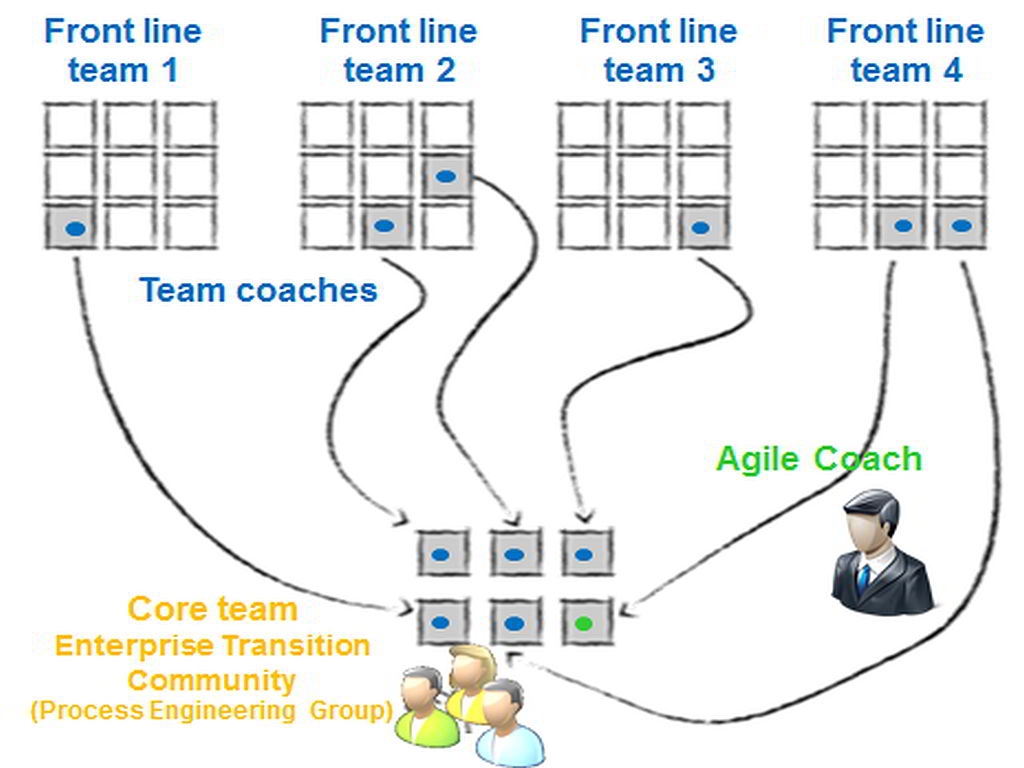20 Success Factors Of Organisational Change
Why Changing Organisational Culture Is a Myth
You can not change the culture of your business or organisation. Period.
You can only try to motivate the people in your organisation to change. And the "culture change" you will get will be the result how people will behave in a new and different way. And more, you can not expect that they behave how you want they should. However, you can try to support and affect them.
These are the reasons, why you can not run "cultural change" like a traditional project with given start time, planned end time and finished roll out of the implemented results.
Change is not an event. Change never stops. Change is a process. Change is continuous.
20 Factors To Influence Organisational Change
It’s difficult to change organisations since it’s difficult to affect employees to change. Employees fear change. Employees resist change. In organisational change initiatives, you are confronted with
- Resistance
- Fear
- Loss of Trust
- No-Commitment
- Resignation
However, there are 20 factors to influence organisational change.
1. Call for Active Management Attention and Support
As Board member or as a manager:
- Walk your talk! – Be present at all levels.
- Trust your employees – let them detail high-level change objectives from their perspective and needs.
- Let them contribute in activities, artefacts, processes, and procedures.
- Allocate needed resources.
- Serve your employees.
- Define yourself by accomplishments of your employees.
2. Have a Realistic Schedule
Don’t under-estimate the effort:
- You can harvest the new culture & benefits after rollout not earlier than: 3 years
- Implementing Change at least (see John Kotter’s phase model): 1-2 years
- Time to acclimate to the new culture (further marketing the change): 1 year
Don’t accept management wish-thinking!

3. Offer your Assistance and Guidance At All Levels
- Help with assistance and guidance
- Support the front line actively with engagement, knowledge and technology in all improvement activities
- Explain unmovable constraints
- Remove impediments
Stop Wasting People’s Time!
4. Create Shared Visions by Valuing Personal Visions
Respect and value your employee's personal vision: the Personal Visions defines personal identity, attitudes, behaviours, empathies, and resistances.
- Use personal visions to create Shared Visions.
- Shared Visions build Collective Identity.
- Match Change’s objectives with employee's Personal Visions.
- Identify resistance and blockers as fast as possible.
- Use LEGO Serious Play workshops to develop a Shared Vision correlated to employees vision and change initiative objectives.
- Use Team Chartering to find team values.
5. Assure Employees to Trust and to be Trusted
An Organisation has always to fulfil the Trust of its employees. Because employees trust in them!
- Involve all who have needs.
- Show improvement actions on all operational levels transparently.
- Align and engage change with the business.
- Motivate by giving confidence and responsibilities.
- Allow mistakes.
6. Be always Transparent on All Levels
Show Transparency as much as possible:
- Deploy Early and Often.
- Show progress / results all-time.
- Communicate success, problems, and failures.
- Make all data highly available (whiteboard at a prominent place).
- Involve at all levels employees in detailing high-level change objectives to their needs.
- Establish feedback cycles and discussion forums.
7. Strive for Mutual Commitment
You get no Commitment by management top-down-orders only.
It’s a 2-side coin: if you are not committed yourself, you get no commitment.
Build commitment on:
- Trust and Transparency on both sides always.
- Motivation (on individual, team, and department / management level).
- Embedding in decisions all involved.
- Showing everybody personal benefits and values.
- Creating “Small World Networks” spreading connections feature-driven.
8. Establish Active Communities to Drive the Change
Establish teams and communities on several organisational levels to drive, support, and promote the change at the front line:
- Change Steering Group (CSG) or Enterprise Transition Community (ETC) – This is the core team driving the change. ((The term "Process Engineering Group" was coined originally 1988 in software process improvement concepts like CMM and CMMI. Mike Cohn introduced for agile transition "Enterprise Transition Communities". ETCs are variants of Communities of Practice, CoP.))
Members of the ETC/PEG should be representatives of all teams and departments vertically and horizontally involved.
This team supports actively on all levels employees in finding objectives, implementing, and roll out the change. It is the first and single contact for suggestions and complaints regarding change.
Everybody in the organisation should be aware that this core team is responsible for the change initiative. - Change Agents – a team of representatives of all management levels. They promote and multiply the change. Some of the change agents should be part of the core team ETC/PEG as well.
- Change Facilitator, Agile Coach: systemic supervision by one or more people with agile and lean mindset.
9. Communicate! Communicate! Communicate!
Share whenever and wherever:
- …success stories as well as stories about failures.
- …constraints, objectives, resources, and goals.
- …motivation and benefits.
- …time lines and schedules.
10. Create Impact at All Levels
- Spread across the organisation that your grass is greener – use the domino effect: “Let me join your team!”
- Give employees room for feedback.
- Let employees experience improvement benefits personally – “Continuous Improvement Process”.
- Engage enthusiastically supportive employees.
- Reward by giving responsibilities or status – do not reward by money.
11. Create an Experimentation Culture
- Roll out Iteratively.
- Prototype / Test all improvement ideas – even the smallest one – at the frontline.
- Keep test teams small (3 ppl).
- Test repeatedly and often.
- Constantly remove guesswork.
- Be metrics driven – define metrics by prototype’s usage / purpose.
- Make all data highly available.
- Encourage employees’ engagement.
- "Small Experiments": Inspect and adapt all your deliveries immediately. Monitor and track your experiments always (Lean Change Canvas).
- Allow failures – tests can fail! In this case, focus on the process that led to the mistake rather than pointing a finger of blame at someone. When errors do occur, the objective should be to learn from the experience and do things a little better the next time around.
12. Find Solutions in a Playful Way
Playing
- …addresses emotionally
- …energises with fun
- …motivates by heart
- …commits easily
- … connects people and goals
- … transfers goals and objectives
- … opens creativity quickly via metaphors, pictures, symbols, storytelling
13. Challenge and Engage Employees
- Get enthusiastic support and buy-in upfront
- Assign neutral facilitator(s) to assure everyone will be heard
- Use engaging collaboration formats and facilitation (Open Space, Barcamp, Fish-Bowl, World Café, Innovation Games, Agile Games, LEGO Serious Play)
- Create Declarations of Understanding
- Celebrate successes
14. Align Change Activities on Value Stream and on Business
Value (of the change) is pertinence of usage the change brings to organisation / frontline.
Identify waste using Games and Retrospectives (Innovation Games).
Assess projects and teams in terms of
- …creating flow by eliminating waste.
- …needs / business value / importance
Select “pilot projects” for change activities / artefacts according to business needs and value stream.
15. Think Lean
Prototype and Deliver Value
Prototype early – Don’t over-engineer.
Ship directly usable artefacts time-boxed and incrementally.
Establish reliable metrics and reporting cycles.
Use, evaluate, and improve all shipped artefacts immediately:
- “Build-Measure-Learn”
(Lean Change Managemen and Lean-Startup-Cycle, Eric Ries)
 16. Visualise and Monitor Progress Continuously
16. Visualise and Monitor Progress Continuously
Visualise teams the impact of their change activities (on whiteboards or with the Lean Change Canvas).
Monitor Progress with Lean Change Canvas metrics:
- Urgency: “What is urgency?” “From who’s perspective?”
- Change Recipients: “Who is affected?” – “How many?”
- Vision: “What’s the goal intended?”
- Communication: “How will we communicate?”
- Success Criteria: “When will change stick?” – “What’s the definition of Done?”
- Target State: “Where do we want to go?”
- Required Investments (effort): “What should we prepare?” – “How much?”
- Benefits / Wins (not monetary only): “Who gains most?” – “How much?”
17. Think Agile. Establish Rollout Policies
- Implement artefacts with daily feedback loops in core team (24hrs)
- Release artefacts with directly usable increments in 2wks sprints
- Define retrospective intervals per sprints
- Define success criteria (“Definition of Done”)
18. Scale the Change
Use same agile rollout policies in the line as in core team:
- Incremental releases (24hrs/2wks)
- Build-Measure-Learn cycle
19.Create Learnings Regularly
Use Retrospectives (i.e. regular team meetings after 4-6 sprints each) to:
- “Inspect & Adapt” – reflect with core team and others involved their way of working, and how to continuously improve
- identify and commit actions to be done to improve
- empower teams and improve the team productivity
- increase product quality
- identify impediments
- collect learnings
- adapt to changing objectives and requirements
4 Questions:
1.“How are we doing?”
2.“What's going well?”
3.“What's not going well?”
4.“What steps can we take to improve?”
20.Forget about pleasing everybody: Offer Alternatives
You can’t get everyone on the bandwagon .
Permanent motivating, explaining, and convincing demotivated people puts pressure on you and slows down the transformation.
Provide Alternatives / Exit strategies to employees not willing to follow the change:
- moving to new teams / departments with same mind sets
- telework opportunities
- early retirements
- cancellation agreements
- pay employees to quit (Zappos, Amazon)
Get your team on board as fast as possible. Rollout and deliver incrementally. Keep the bandwagon motivated and engaged all times.
Free Give Away
: FTTUB Federation of Transport Trade Union via flickr.com • Morgan, via flickr.com • Ivan Niznicki, via flickr.com • Elvin, via flickr.com • Nick Ford, via flickr.com • Nina Matthews, via flickr.com • Prasanth Chandran, via flickr.com • David Wall, via flickr.com • Marc Wathieu, via flickr.com • Jekurantodistaja, via flickr.com • Richard Parmiter, via flickr.com • kafka4prez, via flickr.com • Steven Zwerink, via flickr.com • Kevin Lau via flickr.com • rabiem22 via flickr.com, .





















Leave A Comment